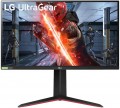Surface treatment
Modern monitors can use displays with both glossy and matte screen surfaces.
A matte surface is in some cases more preferable due to the fact that on a
glossy screen, when exposed to bright light, noticeable glare appears, sometimes interfering with viewing. On the other hand, glossy screens offer better picture quality, higher brightness, and richer colours.
Due to the development of technology,
monitors with a special anti-glare coating have appeared on the market, which, while maintaining all the advantages of a glossy screen, creates significantly less visible glare in bright ambient light.
Colour space (sRGB)
Monitor colour gamut Rec. 709 or sRGB.
Any colour gamut is indicated as a percentage, however, not relative to the entire variety of visible colours, but relative to the conditional colour space (colour model). This is due to the fact that no modern screen is able to display all the colours visible to humans. However, the larger the colour gamut, the wider the monitor's capabilities, the better its colour reproduction.
Nowadays, sRGB is actually the standard color model adopted for computer technology; This is what is used in the development and production of most video cards. For television, the Rec. standard, similar in parameters, is used. 709. In terms of the range of colors, these models are identical, and the percentage of coverage for them is the same. In the most advanced monitors it can
reach or even exceed 100%; These are the values that are considered necessary for high-end screens, incl. professional.
Colour gamut (DCI-P3)
The color gamut of the monitor according to the DCI P3 color model.
Any color gamut is indicated in percentages, but not relative to the entire variety of visible colors, rather relative to a conventional color space (color model). This is because no modern screen can display all the colors visible to the human eye. Nevertheless, the larger the color gamut, the broader the monitor's capabilities, and the better its color reproduction quality.
DCI P3 is a professional color model mainly used in digital cinemas. It is significantly broader than the standard sRGB, providing more accurate and high-quality colors. Accordingly, the percentage values are lower—for example, 115% coverage in sRGB corresponds to approximately 90% coverage in DCI P3; in the most advanced modern monitors, coverage according to this standard is
98 – 100%. At the same time, supporting DCI-P3 is costly, which is why it is mainly found in high-end monitors for professional and gaming purposes.
Portrait pivot
The screen is 90° rotatable on a stand, from landscape (horizontal) to portrait (vertical). The vertical orientation of the screen (
portrait mode) can be useful, for example, when working with large documents made in portrait orientation.
Screen swivel
The presence of
a swivel stand in the design of the monitor allows you to change not only the angle of the screen (of course everyone has it), but also its rotation to the right and left. The angle of rotation depends on the model, but anyway, even a slight deviation allows you to quickly adjust the position of the monitor to your needs.
Height adjustment
The ability to move the monitor screen up and down relative to the base. This feature is very convenient for
adjusting the height of the screen — moving it on the mount is much easier than looking for a stand or resorting to other tricks.
Power consumption
Rated power consumption of the monitor. Usually, this item indicates the maximum power that the device can consume during normal operation — that is, the energy consumption at maximum brightness, the highest volume of the built-in acoustics, etc. Actual power consumption can be noticeably lower, however, when choosing, it is still best to focus on the value stated in the specifications.
In general, the lower the power consumption, the more economical the device in terms of electricity consumption (ceteris paribus). In addition, this characteristic can be useful when selecting an uninterruptible power supply for a PC and in other specific situations when it is necessary to accurately determine the power consumption of equipment.

